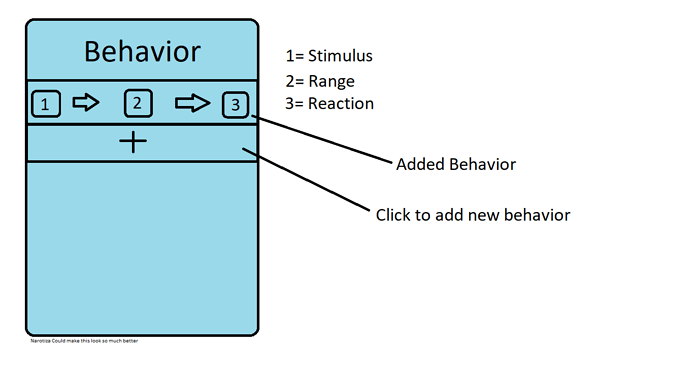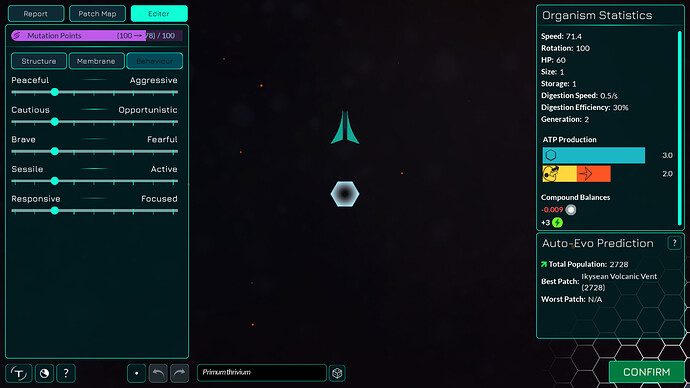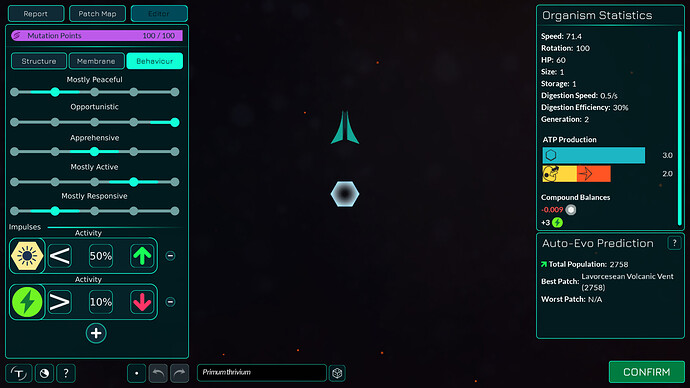Wow it really has been 3 years now huh? I’ve come back to this design now, as we have since implemented a functional behavior editor that allows for a nice amount of flexibility for species. I ask that the previous designs I had be entirely disregarded in favor of the following, as I feel I’ve grown since then.
Today I am going to bring up how we might be able to expand and improve upon the behavior editor going forward, based on how we have seen players interact with it with the following two concepts.
Fixed Adjustments
This editor as it currently stands works well enough, but it is not without it’s faults, namely that the values are currently unclear, and fail to communicate to the player the impact they have on their species.
To potentially solve this, I propose that the behavior sliders be fixed to specific values in increments of 100 each. I believe there is little to no need for controlling the exact value beyond these major increments as they will presumably make little difference in behavior. Doing so will make behavioral adjustment and tweaking more approachable and uniform for players as they will be able to better understand the impact of each adjustment when they are more significant.
If needed or otherwise desired, we could potentially reserve the current slider style for an “advanced option” for those so inclined.
In addition to fixed increments, changing the descriptive term of a species’ behavior based on their current values is worth considering, as it would concisely communicate to the player what to expect from the values they have chosen. A significant downside to this is increased translation burden, as well as the need to provide neutral terms between each extreme (EX: Peaceful, Neutral, Aggressive) which some might argue won’t be worth the effort.
Behavioral Impulse
The behavior editor currently allows players to adjust the general attitude of their species which allows for a great deal of flexibility. However, it currently lacks room for more specific response to stimuli, or behavioral quirks in general.
Main Idea:
I call my solution impulses; The player will be able to designate a particular stimulus, whether it be a particular level of light or perhaps detection of an external compound, that then creates an “impulse” in the species that alters their behavior by decreasing or increasing a chosen behavioral scale.
For example; Upon detecting phosphates with their chemoreceptor, a normally sessile species would have their activity increased.
The use of impulses would be entirely optional, with the player safely being able to ignore the feature if they so chose. But for those inclined, it could provide an entirely new level of engagement.
How it works:
Players would first click the “+” symbol in the Impulse category to bring up a selection menu listing available stimuli to choose from such as light level; Upon selecting their choice, a blank impulse would be created. After creation of an impulse, the player is then free to adjust the available modifiers and target behavior to determine what the impulse does, and when it is triggered. For example; In the concept art above, the player has created an impulse that increases activity once available light is above 50%.
Players would be able to make as many impulses as they desire, as well as freely delete any they no longer need or want.
Matters of Progression:
While the use of impulses is entirely optional, it is still helpful to ease it’s introduction to players overtime.
In the beginning, players would not have access to any stimuli. They would only be able to adjust the behavioral sliders to determine their species’ attitude. However, by possessing certain parts that allow them to sense things beyond primitive means, the player will be provided with new stimuli with which they can create impulses. For example, evolving a thylakoid could unlock lux level for impulses.
The idea is that as the species becomes more complex, it’s behavioral options begin to expand as well.
Connections to the process panel:
In the future, it may be attractive to bridge functionality between impulses and the process panel as devised in the past. Instead of altering behavioral scales, an impulse could instead be made to automatically deactivate/reactivate certain processes in the right conditions, allowing for effective automation of the process toggling feature. This would also potentially allow the AI to use the feature.
An example of this would be an impulse shutting off all rustycyanin when there is no available iron to process.
Such advanced functions could be locked behind the nucleus, or possibly nervous systems In later stages to roughly simulate the presence and evolution of an endocrine response system.
The UI as depicted in my concept should not be taken as a final rendition (unless the graphics team loves it, I doubt it) and I would strongly encourage we receive some input from the graphics team on how best to present the feature before attempting proper implementation.
The end result should be a more engaging and approachable behavior editor, featuring both easy to use scales for new players to quickly alter, and a more advanced and in depth but entirely optional impulse system for more advanced players to sink their teeth into.
I hope that I adequately explained my thoughts on an expanded behavioral editor! If there is anything particularly unclear or poorly explained don’t be afraid to ask me to elaborate. Please let me know what y’all think!


